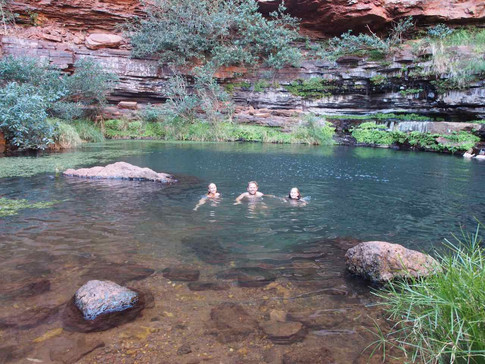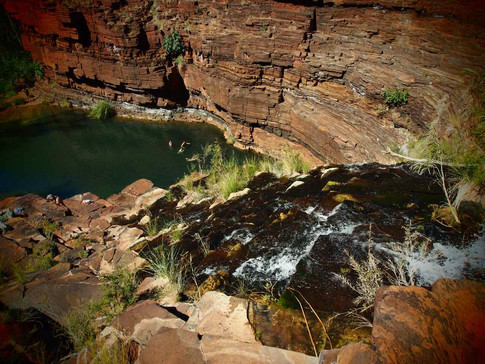KARIJINI NATIONAL PARK, PILBARA, Western Australia
- visited 7 - 13 May 2016
- May 19, 2016
- 5 min read
The Pilbara is an extraordinary place.
To the local indigenous peoples, it is a place of exceptional spiritual meaning. It’s easy to see why. The unbelievable colours and breathtaking geography fill you with awe. It’s a place where time seems to have stood still; largely untouched for millions of years, the landscape is raw. And everything seems scaled up – the long, arid plains, the deep, life giving gorges, the unending blue skies, the intolerable Summer heat and freezing Winter nights, the night skies twinkling with billions more stars than (seemingly) anywhere else and the enormous four-trailer road trains. Mountains burst from the Earth, evidence of an ancient time when unimaginable forces heaved these huge lumps of land from far underground. Despite its violent beginning, some 2.5 billion years ago, it’s a peaceful place; somewhere that demands respect.
Yet, the Pilbara is also home to thriving mining industries of crude oil, salt, natural gas and iron ore. Massive open cut pits scar this unique landscape, and impossibly large salt mounds demonstrate the versatility of resources that exist in this incredible place. These industries bring significant wealth and high employment to the region and will dominate the economy for as long as the resources are plentiful. I’m sure the issue of mining in the Pilbara will continue to divide opinion but we found, from our limited experience, that it seems to successfully co-exist with tourism…for now.
We spent most of our time in the Karijini National Park. The Park is set in the Hamersley Ranges and is the second largest National Park in Australia. Its 630,000 ha accommodates a number of different ecosystems, providing visitors with a delightful array of textures, colours and sounds. The treasures hidden beneath the azure skies reveal themselves in the most spectacular fashion once you dare to investigate beyond the visitor centre and carpark lookouts. There is nothing subtle about the spectacles that draw so many people to this Park. There are no soft, pretty layers of pastel flowers or slow, meandering rivers. Instead, you are confronted by sheer cliffs of banded iron with shrubs clinging precariously at strange angles to small patches of red earth, gaping canyons that drop more than 100m and inhospitable plains covered with spikey spinifex. Standing atop the deep gorges, you wonder in amazement at what Nature is capable of. How millions of years of erosion have sculptured and carved the rock, and how it will continue for millions more. How the elegant trickles of water that feed the waterfalls and streams become violent torrents after storms, submerging so much of what is visible now. This really is a place of wonder.
There are gorges and walks with different levels of difficulty dotted throughout the east and west of the Park. We concentrated on four of the more popular and challenging walks in the east section and we were not disappointed. Access to Circular Pool, Fortescue Falls and Fern Pool is via the same set of steep, leg cramping stone steps. The climb allows a quick (depending on level of fitness!!) descent into the bottom of the canyon, after which you hike in a more horizontal manner to each of the star attractions. Conversely, the track to Kermits Pool in Hancock Gorge takes a slower descent with more demanding and interesting obstacles along the way, including sections you need your bathers for and the ‘Spiderman walk’ where you crawl, sider-like, along the sides of a narrow section of rock wall. At each destination an impossibly deep pool of crystal clear water, fed by cascading waterfalls or seasonal streams, greets you. The long shadows created by the soaring cliffs prevent the sun’s warming rays from piercing the depths of these pools. Instead of hues that reflect the endless blue skies, the water shines like onyx. Some are so cold they take your breath away. Despite cool temperatures (in the low-mid 20’s), we all committed to a baptism in each pool. The experience was both refreshing and delightful. I could attempt to describe these amazing gorges but as they say “a picture tells a thousand words”. No amount of creative writing could match the impact of my photos. I apologise for the volume of shots but I hope they give you an appreciation of the beauty and excitement of the Park!
We couldn’t stay in Karijini - dogs are not welcome in National Parks. Instead, we camped at ‘Albert Tognalini’, an amazing free camp ground 50km from the entry to the Park. (Except for the first night when we camped at a roadside stop…OMG THE FLIES, and the bugs, and the all night road trains. It was horrible!) Michael and I took turns to visit the Park with the kids, alternating days so one of us could stay behind with the puppies. It worked out well – we got to have a rest day in between the strenuous walks and the kids got worn out by going every day!! The camp site had incredible views and despite 2 days of 50km+ winds, it was a prefect place to enjoy the Pilbara.
We also briefly visited Wittenoom...well, at least the town ‘formally known as Wittenoom’. Perhaps best known for being referenced in Midnight Oil’s song Blue Sky Mine, Wittenoom does not officially exist anymore! It was de-gazetted in 2007, meaning it is no longer a recognised town - there are no ‘official’ town signs, it no longer receives government services, has no mains power and is no longer included on maps when they are made! Despite this, 3 people still live there, refusing the meagre Government offers to buy their properties and move them somewhere ‘safer’. Asbestos was heavily mined in Wittenoom for decades until 1960’s. Operations only ceased after someone finally accepted that asbestos fibres, which float around when the asbestos is disturbed, get lodged in peoples lungs and kills them! Hundreds of former Wittenoom mine workers and residents have since died from mesothelioma, lung cancer and asbestosis. At its peak in the mid 60’s Wittenoom was bigger than Tom Price with 500 residents as well as a hospital, police station, courthouse, three churches, the Fortescue Hotel and an airport. Since then, it has become a deserted ghost town where evidence of its hay day has long gone. It was certainly an interesting addition to our travels but we were glad to move on!
GENERAL IMAGES OF THE PILBARA
PHOTOS FROM HANCOCK GORGE (the kids & i enjoyed this the most, Michael preferred Circular Pool)
IMAGES FROM CIRCULAR POOL
IMAGES FROM FERN POOL
IMAGES FROM FORTESCUE FALLS
IMAGES FROM THE CAMP GROUND, ALBERT TOGNALINI





































































































Comments